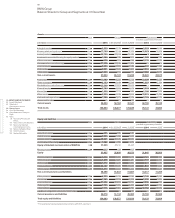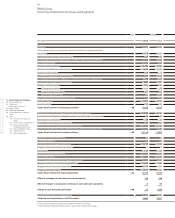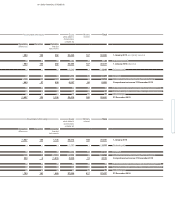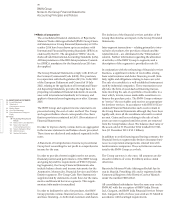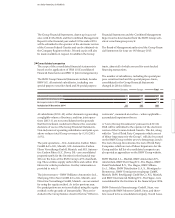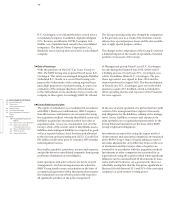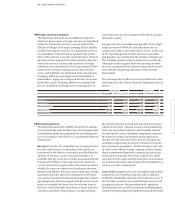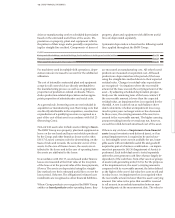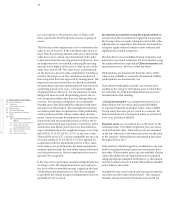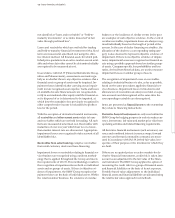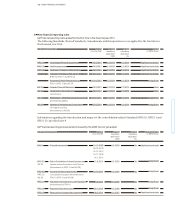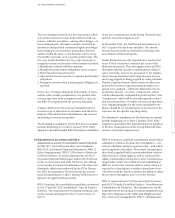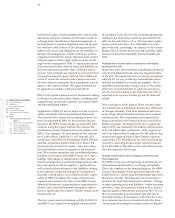BMW 2014 Annual Report Download - page 102
Download and view the complete annual report
Please find page 102 of the 2014 BMW annual report below. You can navigate through the pages in the report by either clicking on the pages listed below, or by using the keyword search tool below to find specific information within the annual report.
102
90 GROUP FINANCIAL STATEMENTS
90 Income Statements
90 Statement of
Comprehensive Income
92 Balance Sheets
94 Cash Flow Statements
96 Group Statement of Changes in
Equity
98 Notes
98 Accounting Principles and
Policies
116 Notes to the Income Statement
123 Notes to the Statement
of Comprehensive Income
124
Notes to the Balance Sheet
149 Other Disclosures
165 Segment Information
of other intangible assets relating to production), write-
downs on inventories, freight and insurance costs re-
lating
to deliveries to dealers and agency fees on direct
sales. Expenses which are directly attributable to finan-
cial services business (including depreciation on leased
products), the interest expense from refinancing the
entire financial services business as well as the expense
of risk provisions and write-downs relating to such busi-
ness are also reported in cost of sales.
In accordance with IAS 20 (Accounting for Government
Grants and Disclosure of Government Assistance), pub-
lic sector grants are not recognised until there is reason-
able assurance that the conditions attaching to them
have been complied with and the grants will be received.
They are recognised as income over the periods neces-
sary to match them with the related costs which they are
intended to compensate.
Basic earnings per share are computed in accordance with
IAS 33 (Earnings per Share). Basic earnings per share
are calculated for common and preferred stock by di-
viding
the Group net profit after minority interests, as
attributable to each category of stock, by the average
number of outstanding shares. The net profit is accord-
ingly allocated to the different categories of stock. The
portion of the Group net profit for the year which is not
being distributed is allocated to each category of stock
based on the number of outstanding shares. Profits
available for distribution are determined directly on the
basis of the dividend resolutions passed for common
and preferred stock. Diluted earnings per share are dis-
closed separately.
Share-based remuneration programmes which are ex-
pected
to be settled in shares are, in accordance with
IFRS 2 (Share-based Payments), measured at their fair
value at grant date. The related expense is recognised
in the income statement (as personnel expense) over
the vesting period, with a contra (credit) entry recorded
against capital reserves.
Share-based remuneration programmes expected to be
settled in cash are revalued to their fair value at each
balance sheet date between the grant date and the settle-
ment
date and on the settlement date itself. The
ex-
pense for such programmes is recognised in the income
statement (as personnel expense) over the vesting period
of the programmes and recognised in the balance sheet
as a provision.
The share-based remuneration programme for Board
of
Management members and senior heads of depart-
ment
entitles BMW AG to elect whether to settle its
commitments in cash or with shares of BMW AG
com-
mon stock. Following the decision to settle in cash,
this programme is accounted for as a cash-settled
share-based transaction. Further information on
share-based remuneration programmes is provided
in note 20.
Purchased and internally-generated intangible assets are
recognised as assets in accordance with IAS 38
(Intan-
gible Assets), where it is probable that the use of the asset
will generate future economic benefits and where the
costs of the asset can be determined reliably. Such assets
are measured at acquisition and / or manufacturing cost
and, to the extent that they have a finite useful life,
amortised over their estimated useful lives. With the ex-
ception
of capitalised development costs, intangible
assets are generally amortised over their estimated use-
ful lives of between three and ten years.
Development costs for vehicle and engine projects are
capitalised at manufacturing cost, to the extent that
attributable costs can be measured reliably and both
technical feasibility and successful marketing are as-
sured. It must also be probable that the development
expenditure will generate future economic benefits.
Capitalised development costs comprise all expenditure
that can be attributed directly to the development pro-
cess, including development-related overheads. Capi-
talised
development costs are amortised systematically
over the estimated product life (usually four to eleven
years) following start of production.
Goodwill arises on first-time consolidation of an acquired
business when the cost of acquisition exceeds the
Group’s share of the fair value of the individually iden-
tifiable assets acquired and liabilities and contingent
liabilities assumed.
All items of property, plant and equipment are considered
to have finite useful lives. They are recognised at acqui-


